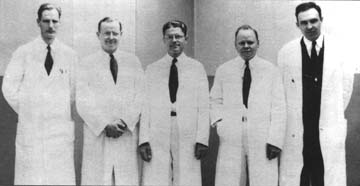NIDA's Addiction Research Center (ARC) marked its 60th anniversary in 1995. Over the years, the mission of the ARC, which is NIDA's Division of Intramural Research (DIR), has remained unchanged. It continues to conduct coordinated, multi-disciplinary research on all aspects of drug abuse and to apply that knowledge to make drug abuse prevention and treatment more effective.
"Intramural research plays an important role in drug abuse research in this country," says DIR Acting Scientific Director Dr. George R. Uhl, who also heads the Molecular Neurobiology Branch. NIDA's extramural and intramural systems of conducting research are complementary and ensure that a broad range of approaches to difficult scientific issues is being pursued in both programs, Dr. Uhl stresses.
Over the years, NIDA's intramural research program has demonstrated its value through the results it has achieved (see "History of ARC Marked by Research Achievements"). In the last few years alone, DIR researchers have evaluated a number of existing medications as proposed cocaine treatment compounds; played a leading role in the attempt to discover and develop novel cocaine treatment medications; contributed significant research data on two opiate treatment medications, LAAM (l-alpha-acetyl-methadol) and buprenorphine; cloned primary brain receptors for cocaine and heroin; and helped develop effective behavioral therapies for cocaine addiction. In addition, the DIR has trained hundreds of drug abuse researchers as well as high school and college teachers who educate students about drug abuse.
 ARC's first staff: psychologist Ralph Brown, chemist Fred Oberst, psychologist and ARC's first director Clifton Himmelsbach, physiologist Edwin Williams who would become ARC's second director, and biophysicist Howard Andrews.
ARC's first staff: psychologist Ralph Brown, chemist Fred Oberst, psychologist and ARC's first director Clifton Himmelsbach, physiologist Edwin Williams who would become ARC's second director, and biophysicist Howard Andrews.In recent years, the DIR has expanded its basic and clinical research facilities in Baltimore to grapple with the complex scientific issues and constantly evolving public health questions that face the field of drug abuse and addiction research today. Currently, the intramural research program operates the largest research facility in the United States devoted to studying drug abuse and addiction - a 60,000-square-foot building and parts of two nearby buildings on the Bayview campus of Johns Hopkins University. Research resources include a state-of-the-art brain imaging center dedicated to drug abuse research, a 26-bed inpatient treatment research unit, and an 80-slot outpatient treatment research unit.
Nearly 100 scientists work atthe ARC in six research branches - molecular neurobiology, preclinical pharmacology, neuroscience, clinical pharmacology, treatment research, and etiology. Scientists in these branches conduct basic and clinical studies that explore the biological roots, brain sites, mechanisms, and consequences of addiction; the actions and effects of abused drugs in animals and humans; and behavioral and pharmacological therapies aimed primarily at cocaine and opiate addiction.
One of the unique strengths of the DIR is that scientists from separate branches can work together to mount comprehensive studies that examine the same aspect of drug abuse and addiction from different scientific perspectives. For example, in the attempt to develop new medications to treat opiate and cocaine addiction, DIR researchers have taken studies of new compounds from basic molecular levels and animal models to clinical trials with patient volunteers.
While continuing to meet the current challenges for drug abuse research, such as the need for cocaine treatment medications and the transmission of HIV through drug use, the DIR is also moving to address more fundamental questions about drug abuse and the long-term brain changes that accompany addiction, says Dr. Uhl. Current questions on these frontiers of drug abuse research are: What accounts for individual differences in vulnerability to addiction? In other words, what are the genetic and environmental factors that, once identified, can be targeted with more effective prevention and treatment interventions? And what are the neurobiological mechanisms and brain changes that occur with the long-term abuse of drugs to produce such difficult-to-treat phenomena as craving and relapse?
As the DIR's accomplishments over the past 60 years have shown, the cutting-edge science of its six research branches, which is highlighted in this special report, will play an important role in providing answers to these questions. In turn, this information will provide the scientific foundation for developing the drug addiction treatment medications and behavioral interventions of the 21st century.
